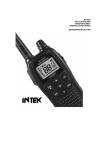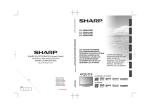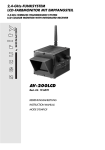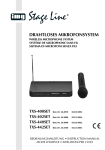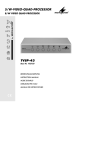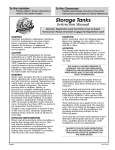Download Monacor VAM-3 Instruction manual
Transcript
2,4-GHz-FUNKSYSTEM FÜR AUDIO-/ VIDEOÜBERTRAGUNG 2.4 GHz WIRELESS AUDIO / VIDEO TRANSMISSION SYSTEM AV-200SET AV-210R BEDIENUNGSANLEITUNG INSTRUCTION MANUAL MODE D’EMPLOI Best.-Nr. 19.4030 Best.-Nr. 19.4080 ® DEUTSCH ENGLISH Before switching on … FRANÇAIS Bevor Sie einschalten … Wir wünschen Ihnen viel Spaß mit Ihrem neuen Gerät von MONACOR. Bitte lesen Sie diese Bedienungsanleitung vor dem Betrieb gründlich durch. Nur so lernen Sie alle Funktionsmöglichkeiten kennen, vermeiden Fehlbedienungen und schützen sich und Ihr Gerät vor eventuellen Schäden durch unsachgemäßen Gebrauch. Heben Sie die Anleitung für ein späteres Nachlesen auf. Der deutsche Text beginnt auf der Seite 6. We wish you much pleasure with your new MONACOR unit. Please read these operating instructions carefully prior to operating the unit. Thus, you will get to know all functions of the unit, operating errors will be prevented, and yourself and the unit will be protected against any damage caused by improper use. Please keep the operating instructions for later use. The English text starts on page 9. Avant toute installation … Nous vous souhaitons beaucoup de plaisir à utiliser cet appareil MONACOR. Lisez ce mode d'emploi entièrement avant toute utilisation. Uniquement ainsi, vous pourrez apprendre l’ensemble des possibilités de fonctionnement de l’appareil, éviter toute manipulation erronée et vous protéger, ainsi que l’appareil, de dommages éventuels engendrés par une utilisation inadaptée. Conservez la notice pour pouvoir vous y reporter ultérieurement. La version française se trouve page 12. 3 4 1 2 3 2 1 3 ➀ 4 4 6 5 ➁ AV-... ® Best.-Nr. 19... Pegel Empfänger Receiver 2 3 9 5 6 0 1 4 7 8 5 6 ➂ 5 DEUTSCH 6 Bitte klappen Sie die Seite 5 heraus. Sie sehen dann immer die beschriebenen Bedienelemente und Anschlüsse. Inhalt 1 Übersicht der Bedienelemente und Anschlüsse . . . . . . . . . . . . . . . . . . . . . . . . . 6 1.1 Anschlüsse an der Sende- und an der Empfangsstation . . . . . . . . . . . . . . . . 6 1.2 Geräteunterseite . . . . . . . . . . . . . . . . . . . . . . 6 2 Hinweise für den sicheren Gebrauch . . . . 7 3 Einsatzmöglichkeiten . . . . . . . . . . . . . . . . . 7 3.1 Konformität und Zulassung . . . . . . . . . . . . . . 7 4 Inbetriebnahme . . . . . . . . . . . . . . . . . . . . . . 7 4.1 Platzierung der Sende- und der Empfangsstation . . . . . . . . . . . . . . . . . . . . . . . . . . . . . . 7 4.2 Übertragungskanal einstellen . . . . . . . . . . . . 7 4.3 Geräte anschließen . . . . . . . . . . . . . . . . . . . . 8 4.4 Audio- und Videopegel korrigieren . . . . . . . . 8 5 Technische Daten . . . . . . . . . . . . . . . . . . . . 8 1 Übersicht der Bedienelemente und Anschlüsse 1.1 Anschlüsse an der Sende- und an der Empfangsstation 1 Antenne (nicht verkratzen oder abbrechen) 2 Betriebsanzeige, nur an der Sendestation 3 DIN-AV-Buchse, Anschlussbelegung (Abb. 2): 1 — 2 Videosignal, 1 Vss 3 Masse 4 Audio, links 5 nur an der Empfangsstation: Ausgang Versorgungsspannung +5 V, max. 80 mA für Zusatzgeräte, z. B. HF-Modulator 6 Audio, rechts (nur bei Stereo) 4 Kleinspannungsbuchse zur Spannungsversorgung der Sender benötigt 12 V /150 mA, der Empfänger benötigt 8 – 10 V /320 mA; Mittelkontakt = Pluspol; benötigter Kleinspannungsstecker 5,5/2,1 mm (Außen-/Innendurchmesser) 1.2 Geräteunterseite 5 Trimmregler am Empfänger zum Korrigieren des Videopegels, wenn am Wiedergabegerät (z. B. TV-Gerät, Überwachungsmonitor) das Bild zu hell oder zu dunkel ist am Sender zum Korrigieren des Audiopegels, wenn die Tonübertragung zu leise oder verzerrt ist 6 Schalter für den Übertragungskanal; ab Werk auf Kanal 1 eingestellt Hinweise für den sicheren Gebrauch Das 2,4-GHz-Funksystem entspricht allen erforderlichen Richtlinien der EU und ist deshalb mit gekennzeichnet. ● Das System ist nur zur Verwendung im Innenbereich geeignet. Schützen Sie es vor Verschmutzung, Feuchtigkeit und extremen Temperaturen (zulässiger Einsatztemperaturbereich -10 °C bis +55 °C). ● Die Antenne (1) nicht abbrechen oder verkratzen. Sie ist fest montiert. Versuchen Sie nicht, die Antenne aus dem Gerät herauszuziehen. ● Verwenden Sie für die Reinigung nur ein trockenes, weiches Tuch, auf keinen Fall Chemikalien oder Wasser. ● Wird das Übertragungssystem zweckentfremdet, nicht richtig angeschlossen, falsch bedient oder nicht fachgerecht repariert, kann keine Haftung für daraus resultierende Sach- oder Personenschäden und keine Garantie für das System übernommen werden. Soll das System endgültig aus dem Betrieb genommen werden, übergeben Sie es zur umweltgerechten Entsorgung einem örtlichen Recyclingbetrieb. 3 3.1 Konformität und Zulassung Hiermit erklärt MONACOR INTERNATIONAL, dass sich das Funksystem AV-200SET in Übereinstimmung mit den grundlegenden Anforderungen und den übrigen einschlägigen Bestimmungen der Richtlinie 1995/5/EG befindet. Die Konformitätserklärung kann im Internet über die Homepage von MONACOR INTERNATIONAL (www.monacor.com) abgerufen werden. Das Funksystem ist für den Betrieb in den EU- und EFTA-Staaten allgemein zugelassen und anmeldeund gebührenfrei. 4 DEUTSCH 2 Inbetriebnahme 4.1 Platzierung der Sende- und der Empfangsstation Die beste Empfangsqualität erhält man, wenn die Antennen (1) der Stationen parallel zueinander stehen. Erfahrungen aus der Praxis haben gezeigt, dass ein optimaler Empfang bei einer Aufstellung in einer Höhe von mindestens 1,5 bis 2 m über dem Boden erreicht wird. Vor der endgültigen Montage sollte ein Probebetrieb erfolgen, denn durch Verschieben der Sende- und der Empfangsstation um nur einige Zentimeter kann sich die Übertragungsqualität erheblich ändern. Einsatzmöglichkeiten Das 2,4-GHz-Funksystem überträgt drahtlos TV-/ Video-Bild und Stereo-HiFi-Ton. Dazu sind die folgenden Geräte verfügbar: AV-200SET Komplettset mit Sender und Empfänger mit Stereoton. Zur gleichzeitigen Übertragung unterschiedlicher Signale (z. B. Kinderzimmerüberwachung und Musikübertragung) können bis zu drei Sets parallel genutzt werden. AV-210R Empfangsstation zur Erweiterung des Komplettsets, um die Signale zu einem zweiten Gerät zu übertragen An die Sendestation lässt sich z. B. ein Satellitenreceiver, ein Videorecorder, eine HiFi-Anlage oder eine Überwachungskamera anschließen. Die Sendestation überträgt die Signale zur Empfangsstation, von wo aus sie zum Wiedergabegerät gelangen (z. B. TV-Gerät, Videorecorder, HiFi-Verstärker oder Überwachungsmonitor). VPS- und Videotextsignale werden dabei selbstverständlich mitübertragen. Die Übertragungsreichweite hängt stark von den örtlichen Gegebenheiten ab. Bei Sichtverbindung zwischen Sender und Empfänger kann sie bis zu 300 m betragen. In Gebäuden reduziert sich die Reichweite jedoch durch die Wände und Decken je nach deren Beschaffenheit auf ca. 30 m. 4.2 Übertragungskanal einstellen Die Funkübertragung erfolgt im 2,4-GHz-Bereich, der vom Hersteller in fünf Kanäle mit einem Abstand von 14 MHz aufgeteilt wurde. Maximal können gleichzeitig drei Kanäle benutzt werden (Kanal 1, 3 und 5), weil zwei direkt nebeneinander liegende Kanäle sich stören. Bei Betrieb mehrerer Funksysteme gleichzeitig wird folgende Kanalwahl empfohlen: bei zwei Systemen: Kanal 1 und 5 bei drei Systemen: Kanal 1, 3 und 5 Die Sende- und die Empfangsstation müssen auf den gleichen Kanal eingestellt sein, anderenfalls ist keine Übertragung möglich. Vom Werk aus sind die Geräte auf Kanal 1 eingestellt. Zum Einstellen des Kanals den Umschalter (6) mithilfe eines Schraubendrehers in die entsprechende Position drehen: Position Kanal 1 1 2 2 3 3 4 4 5 5 6 ... 0 1 7 DEUTSCH 4.3 Geräte anschließen Zum Betrieb der Sende- und der Empfangsstation wird zusätzlich je ein stabilisiertes Netzgerät benötigt, z. B. PS-500ST von MONACOR. Wichtig! Beim Anschluss die Sende- und die Empfangsstation nicht verwechseln, sonst arbeitet das Funksystem nicht. Die Stationen unterscheiden sich äußerlich kaum. Nur die Sendestation hat eine Betriebsanzeige (2). Weiterhin lassen sich die Geräte auf der Unterseite durch den Aufkleber mit dem Schriftzug „Sender“ bzw. „Empfänger“ unterscheiden. 1) Die DIN-AV-Buchse (3) der Sendestation mit dem Audio-(Video)-Ausgang der Signalquelle (z. B. HiFiAnlage, Überwachungskamera, Satellitenreceiver, Videorecorder) verbinden. Ist an der Signalquelle eine Scart-Buchse vorhanden, das beiliegende Scart-Anschlusskabel verwenden und den Schalter am Scart-Stecker in die Position „IN“ stellen. Sind an der Signalquelle Cinch-Buchsen vorhanden, das Cinch-Anschlusskabel verwenden: Den gelben Cinch-Stecker in den Video-Ausgang stecken, den schwarzen Cinch-Stecker in den Ausgang des (linken) Audiokanals und bei einer Stereoton-Übertragung den roten Cinch-Stecker in den Ausgang des rechten Audiokanals. 2) Die DIN-AV-Buchse (3) der Empfangsstation mit dem Audio-(Video)-Eingang des Wiedergabegerätes (z. B. HiFi-Verstärker, TV-Gerät, Überwachungsmonitor) verbinden. Ist an dem Wiedergabegerät eine Scart-Buchse vorhanden, das beiliegende Scart-Anschlusskabel verwenden und den Schalter am Scart-Stecker in die Position „OUT“ stellen. Sind am Wiedergabegerät Cinch-Buchsen vorhanden, das Cinch-Anschlusskabel verwenden: Den gelben Cinch-Stecker in den Video-Eingang stecken, den schwarzen Cinch-Stecker in den Eingang des (linken) Audiokanals und bei einer Stereoton-Übertragung den roten Cinch-Stecker in den Eingang des rechten Audiokanals. Zum Anschluss der Empfangsstation an ein TVGerät ohne Scart- oder Cinch-Buchsen den HFModulator VAM-3 von MONACOR verwenden. Er wird an die Antennenbuchse des TV-Gerätes angeschlossen. 3) An die Gleichspannungsbuchse (4) der Sendeund der Empfangsstation je ein Netzgerät anschließen. Dabei unbedingt die Polung beachten: den Pluspol an den Innenkontakt des Steckers anlegen. An den Netzgeräten die Ausgangsspannung einstellen: 9 V für den Empfänger 12 V für den Sender Erst nachdem alle anderen Anschlüsse ausgeführt sind, die Netzgeräte an eine Steckdose (230 V~/ 50 Hz) anschließen. Das Funksystem ist danach betriebsbereit. Am Sender leuchtet die Betriebsanzeige (2). 4) Ist die Übertragung durch Störungen im gewählten Kanal schlecht, sowohl die Sende- als auch die Empfangsstation auf einen störungsfreien Kanal umschalten. 5) Wird das System längere Zeit nicht benutzt, die Netzgeräte aus den Steckdosen ziehen, weil diese ständig einen geringen Strom verbrauchen. 4.4 Audio- und Videopegel korrigieren 1) Wenn am Wiedergabegerät (TV-Gerät, Überwachungsmonitor) das Bild zu hell oder zu dunkel erscheint, mit dem Regler „Pegel“ (5) an der Empfangsstation den Videopegel korrigieren. Dazu einen Schraubendreher zu Hilfe nehmen. 2) Wenn die Tonwiedergabe verzerrt oder zu leise ist, mit dem Regler „Pegel“ (5) an der Sendestation den Audiopegel korrigieren. 5 Technische Daten Sendeleistung: . . . . . . . . . ≤ 10 mW (EIRP) Sende-/Empfangsfrequenz: . . . . . . . . . . . . . Kanal 1 Kanal 2 Kanal 3 Kanal 4 Kanal 5 2,4145 GHz 2,4285 GHz 2,4425 GHz 2,4565 GHz 2,4705 GHz Antenne: . . . . . . . . . . . . . Platinenantenne Reichweite bei Sichtverbindung: . . bis 300 m in Gebäuden: . . . . . . . . bis 30 m Video Ein- bzw. Ausgang: . . . 1 Vss/75 Ω Bandbreite: . . . . . . . . . 30 Hz bis 5 MHz Audio Ein- bzw. Ausgang: . . . 500 mV/10 kΩ Bandbreite: . . . . . . . . . 15 Hz bis 16 kHz Stromversorgung Sender: . . . . . . . . . . . . 12 V /150 mA Empfänger . . . . . . . . . . 8 – 10 V /320 mA Gehäuseschutzart: . . . . . IP 30 Einsatztemperatur: . . . . . -10 °C bis +55 °C Abmessungen (B x H x T): 80 x 35 x 130 mm Gewicht AV-200SET: . . . . . . . . . 450 g AV-210R: . . . . . . . . . . . 230 g Änderungen vorbehalten. Diese Bedienungsanleitung ist urheberrechtlich für MONACOR ® INTERNATIONAL GmbH & Co. KG geschützt. Eine Reproduktion für eigene kommerzielle Zwecke – auch auszugsweise – ist untersagt. 8 Contents 1 Operating Elements and Connections 1.1 Connections of the transmitter station and the receiver station . . . . . . . . . . . . . . . . . 9 1.2 Lower side of the unit . . . . . . . . . . . . . . . . . . 9 2 Safety Notes . . . . . . . . . . . . . . . . . . . . . . . . 10 3 Applications . . . . . . . . . . . . . . . . . . . . . . . . 10 3.1 Conformity and Approval . . . . . . . . . . . . . . . 10 4 Operation . . . . . . . . . . . . . . . . . . . . . . . . . . 10 4.1 Placing the transmitter station and the receiver station . . . . . . . . . . . . . . . . 10 4.2 Setting the transmission channel . . . . . . . . 10 4.3 Connecting the units . . . . . . . . . . . . . . . . . . 11 4.4 Readjusting the audio and video levels . . . . 11 5 Specifications . . . . . . . . . . . . . . . . . . . . . . 11 1 Operating Elements and Connections 1.1 Connections of the transmitter station and the receiver station ENGLISH Please unfold page 5. Then you can always see the operating elements and connections described. 1 Antenna (do not scratch or break off) 2 Power LED, on the transmitter station only 3 DIN AV jack, pin configuration (fig. 2): 1 — 2 video signal, 1 Vpp 3 ground 4 audio, left 5 on the receiver station only: output of control voltage +5 V, max. 80 mA for additional units, e. g. RF modulator 6 audio, right (for stereo only) 4 Low voltage jack for power supply the transmitter requires 12 V /150 mA, the receiver requires 8 – 10 V /320 mA; centre contact = positive pole required low voltage plug 5.5/2.1 mm (outside/inside diameter) 1.2 Lower side of the unit 5 Trimming control on the receiver for readjusting the video level if the picture on the reproduction unit (e. g. TV set, surveillance monitor) is too bright or too dark on the transmitter for readjusting the audio level if the sound transmission is too low or distorted 6 Selector switch for the transmission channel; factory-set to channel 1 9 ENGLISH 2 Safety Notes The 2.4 GHz wireless system corresponds to all required directives of the EU and is therefore marked with . ● The system is suitable for indoor use only. Protect it against impurities, humidity, and extreme temperatures (admissible ambient temperature range -10 °C to +55 °C). ● Do not scratch or break off the antenna (1). It is rigidly mounted. Do not try to pull it out of the unit. ● For cleaning only use a dry, soft cloth; never use chemicals or water. ● No guarantee claims for the unit and no liability for any resulting personal damage or material damage will be accepted if the transmission system is used for other purposes than originally intended, if it is not correctly connected, operated or not repaired in an expert way. If the system is to be put out of operation definitively, take it to a local recycling plant for a disposal which is not harmful to the environment. 3 Applications The 2.4 GHz wireless transmission system serves for wireless transmission of TV/video pictures and stereo HiFi sound. For this purpose, the following units are available: AV-200SET complete set with transmitter and receiver with stereo sound. For simultaneous transmission of different signals (e. g. monitoring of nursery and music transmission), parallel use of up to three sets is possible. AV-210R receiver station as an extension of the complete set to transmit the signals to a second unit To the transmitter station, e. g. a satellite receiver, a video recorder, a HiFi system, or a surveillance camera can be connected. The transmitter station transmits the signals to the receiver station from where they are fed to the reproduction unit (e. g. TV set, video recorder, HiFi amplifier, or surveillance monitor). Of course, VPS and video text signals are transmitted together with these signals. The transmission range largely depends on the local conditions. Without any obstacles between the transmitter and the receiver, the maximum range may be 300 m. In buildings, however, it is reduced to approx. 30 m by walls and ceilings, depending on their condition. 10 3.1 Conformity and Approval Herewith, MONACOR INTERNATIONAL declare that the wireless system AV-200SET is in accordance with the basic requirements and the other relevant regulations of the directive 1995/5/EC. The declaration of conformity can be found in the Internet via the MONACOR INTERNATIONAL home page (www.monacor.com). The wireless system is licence-free and generally approved for operation in EU and EFTA countries. 4 Operation 4.1 Placing the transmitter station and the receiver station The best reception quality is obtained when placing the antennas (1) of the stations in parallel. Practical experience has shown that an optimum reception is obtained when placing the units at a minimum height of 1.5 m to 2 m above the ground. Prior to final mounting, a trial run is recommended as the transmission quality can be substantially changed by displacing the transmitter station and the receiver station by a few centimetres only. 4.2 Setting the transmission channel The wireless transmission is made in the 2.4 GHz range which has been divided by the manufacturer into five channels with a distance of 14 MHz. As a maximum, three channels can be used simultaneously (channels 1, 3, and 5) as two adjacent channels will interfere with each other. When operating several wireless systems at the same time, the following channel selection is recommended: for two systems: for three systems: channels 1 and 5 channels 1, 3, and 5 The transmitter station and the receiver station must be set to the same channel, otherwise no transmission will be possible. The units are factory-set to channel 1. To adjust a channel, turn the selector switch (6) to the corresponding position by means of a screwdriver: Position Channel 1 1 2 2 3 3 4 4 5 5 6 ... 0 1 For operation of the transmitter station and the receiver station, a regulated power supply unit each is additionally required, e. g. MONACOR PS-500ST. Important! When connecting, do not confuse the transmitter station and the receiver station, otherwise operation of the wireless system will not be possible. The stations are hardly distinguishable by their outward appearance, however, only the transmitter station is provided with a power LED (2). Besides, the units can be distinguished by the labels on their lower sides with the corresponding designation “transmitter” or “receiver”. 1) Connect the DIN AV jack (3) of the transmitter station to the audio (video) output of the signal source (e. g. HiFi system, surveillance camera, satellite receiver, video recorder). If a scart jack is provided on the signal source, use the supplied scart connection cable and set the switch on the scart plug to the position “IN”. If phono jacks are provided on the signal source, use the cable with phono connectors: Connect the yellow phono plug to the video output, connect the black phono plug to the output of the (left) audio channel, and for stereo sound transmission, connect the red phono plug to the output of the right audio channel. 2) Connect the DIN AV jack (3) of the receiver station to the audio (video) input of the reproduction unit (e. g. HiFi amplifier, TV set, surveillance monitor). If a scart jack is provided on the reproduction unit, use the supplied scart connection cable and set the switch on the scart plug to the position “OUT”. If phono jacks are provided on the reproduction unit, use the cable with phono connectors: Connect the yellow phono plug to the video input, connect the black phono plug to the input of the (left) audio channel, and for stereo sound transmission, connect the red phono plug to the input of the right audio channel. To connect the receiver station to a TV set without scart or phono jacks, use the MONACOR RF modulator VAM-3. It is connected to the antenna jack of the TV set. 3) Connect a power supply unit each to the DC jack (4) of the transmitter station and the receiver station. Always observe the correct polarity: The positive pole must be at the inner contact of the plug. Adjust the output voltage on the power supply units: 9 V for the receiver 12 V for the transmitter Make all other connections before connecting the power supply units to a mains socket (230 V~/ 50 Hz). After that, the wireless system will be ready for operation. The power LED (2) on the transmitter will light up. 4) If the transmission is poor due to interference in the selected channel, switch both the transmitter station and the receiver station to an interferencefree channel. 5) If the system is not used for a longer period, disconnect the power supply units from the mains sockets as they will permanently have a low current consumption. ENGLISH 4.3 Connecting the units 4.4 Readjusting the audio and video levels 1) If the picture on the reproduction unit (TV set, surveillance monitor) is too bright or too dark, readjust the video level on the receiver station with the control “Pegel” (level) [5]. Use a screwdriver for this purpose. 2) If the sound reproduction is distorted or too low, readjust the audio level on the transmitter station with the control “Pegel” (level) [5]. 5 Specifications Transmitting power: . . . . . < 10 mW (EIRP) Transmitter/receiver frequency: . . . . . . . . . . . . channel 1 channel 2 channel 3 channel 4 channel 5 2.4145 GHz 2.4285 GHz 2.4425 GHz 2.4565 GHz 2.4705 GHz Antenna: . . . . . . . . . . . . . PCB antenna Transmission range without any obstacles: . 300 m max. in buildings: . . . . . . . . . 30 m max. Video Input or output: . . . . . . 1 Vpp/75 Ω Bandwidth: . . . . . . . . . . 30 Hz to 5 MHz Audio Input or output: . . . . . . 500 mV/10 kΩ Bandwidth: . . . . . . . . . . 15 Hz to 16 kHz Power supply Transmitter: . . . . . . . . . 12 V /150 mA Receiver: . . . . . . . . . . . 8 – 10 V /320 mA Protective class of housing: IP 30 Ambient temperature: . . . -10 °C to +55 °C Dimensions (W x H x D): . 80 x 35 x 130 mm Weight AV-200SET: . . . . . . . . . 450 g AV-210R: . . . . . . . . . . . 230 g Subject to technical modification. All rights reserved by MONACOR ® INTERNATIONAL GmbH & Co. KG. No part of this instruction manual may be reproduced in any form or by any means for any commercial use. 11 FRANÇAIS Ouvrez le présent livret page 5 de manière à visualiser les éléments et branchements. Table des matières 1 Eléments et branchements . . . . . . . . . . . . 12 1.1 Branchements à la station d’émission et à la station de réception . . . . . . . . . . . . . 12 1.2 Face inférieure de l’appareil . . . . . . . . . . . . 12 2 Conseils d’utilisation et de sécurité . . . . 13 3 Possibilités d’utilisation . . . . . . . . . . . . . . 13 3.1 Conformité et autorisation . . . . . . . . . . . . . . 13 4 Fonctionnement . . . . . . . . . . . . . . . . . . . . 13 4.1 Placement des stations de réception et d’émission . . . . . . . . . . . . . . . . . . . . . . . . 13 4.2 Réglage du canal de transmission . . . . . . . 13 4.3 Branchements . . . . . . . . . . . . . . . . . . . . . . . 14 4.4 Correction des niveaux audio et vidéo . . . . 14 5 Caractéristiques techniques . . . . . . . . . . 14 1 Eléments et branchements 1.1 Branchements à la station d’émission et à la station de réception 1 Antenne (ne pas érafler ou casser) 2 Témoin de fonctionnement : uniquement sur la station d’émission 3 Prise DIN AV, configuration de branchement (schéma 2) : 1 — 2 signal vidéo, 1 Vcc 3 masse 4 audio, gauche 5 uniquement sur la station de réception : sortie tension alimentation +5 V, 80 mA max pour appareils supplémentaires, p. ex. modulateur HF 6 audio, droit (uniquement en stéréo) 4 Prise alimentation pour l’alimentation : l’émetteur requiert 12 V /150 mA, le récepteur 8 – 10 V /320 mA contact médian = pôle plus fiche nécessaire 5,5/2,1 mm (diamètre extérieur/ diamètre intérieur) 1.2 Face inférieure de l’appareil 5 Réglage trimmer sur le récepteur pour corriger le niveau vidéo lorsque sur l’appareil de lecture (p. ex. téléviseur, moniteur de surveillance), l’image est trop claire ou trop sombre sur l’émetteur pour corriger le niveau audio lorsque la transmission audio est trop faible ou distordue 6 Sélecteur pour le canal de transmission sortie usine : réglé sur canal 1 12 Conseils d’utilisation et de sécurité Le système de transmission sans fil 2,4 GHz répond à toutes les directives nécessaires de l’Union Européenne et porte donc le symbole . ● Le système n’est conçu que pour une utilisation en intérieur. Protégez-le des salissures, de l’humidité et des températures extrêmes (plage de température de fonctionnement autorisée : -10 °C à +55 °C). ● Ne coupez pas ou n’éraflez pas l’antenne (1). Elle est fixée dans l’appareil. N’essayez pas de la retirer de l’appareil. ● Pour nettoyer les appareils, utilisez uniquement un chiffon sec et doux, en aucun cas de produits chimiques ou d’eau. ● Nous déclinons toute responsabilité en cas de dommages corporels ou matériels résultants si le système de transmission est utilisé dans un but autre que celui pour lequel il a été conçu, s’il n’est pas correctement branché, utilisé ou s’il n’est pas réparé par une personne habilitée ; de même, la garantie deviendrait caduque. Lorsque le système est définitivement retiré du service, vous devez le déposer dans une usine de recyclage adaptée pour contribuer à son élimination non polluante. 3 Possibilités d’utilisation Le système de transmission sans fil 2,4 GHz permet une transmission sans fil d’images TV/vidéo et de son stéréo Hi-Fi. Les appareils suivants sont disponibles : AV-200SET : set complet avec émetteur et récepteur avec son stéréo ; pour une transmission simultanée de divers signaux (p. ex. surveillance de chambre d’enfants et transmission de musique), il est possible d’utiliser en parallèle jusqu’à 3 sets. AV-210R : station de réception pour agrandir le set complet, pour transmettre des signaux vers un autre appareil Sur la station d’émission, on peut p. ex. brancher un récepteur satellite, un magnétoscope, une installation Hi-Fi ou une caméra de surveillance. La station d’émission transmet les signaux vers la station de réception d’où ils sont dirigés vers l’appareil de lecture (p. ex., téléviseur, magnétoscope, amplificateur Hi-Fi ou moniteur de surveillance). Les signaux VPS ou de vidéo texte sont bien sûr transmis avec eux. La portée de transmission dépend grandement de la configuration des lieux. Lorsqu’il n’y a pas d’obstacle entre l’émetteur et le récepteur, la portée peut atteindre 300 m ; dans des bâtiments, selon la nature des murs et plafonds, la portée est réduite à 30 m environ. 3.1 Conformité et autorisation Par la présente, MONACOR INTERNATIONAL déclare que le système de transmission sans fil AV-200SET se trouve en conformité avec les exigences fondamentales et les autres réglementations inhérentes à la directive 1995/5/CEE. Le certificat de conformité peut être appelé via la page d’accueil du site internet de MONACOR INTERNATIONAL (www.monacor.com). Le système de transmission sans fil est autorisé dans l’Union Européenne et les pays de l’A.E.L.E. et ne requiert pas de déclaration. 4 FRANÇAIS 2 Fonctionnement 4.1 Placement des stations de réception et d’émission La qualité de réception est la meilleure lorsque les antennes (1) des stations sont parallèles l’une par rapport à l’autre. L’expérience montre que pour un positionnement des appareils à une hauteur de 1,5 m à 2 m au moins au-dessus du sol, la réception est optimale. Avant le montage définitif, il est conseillé d’effectuer un test car un déplacement des stations de réception et d’émission de quelques centimètres uniquement peut modifier considérablement la qualité de transmission. 4.2 Réglage du canal de transmission La transmission sans fil s’effectue dans la plage 2,4 GHz, divisée en 5 canaux par le fabricant avec un intervalle de 14 MHz. On peut utiliser simultanément 3 canaux au plus (canal 1, 3 et 5) car deux canaux immédiatement proches génèrent entre eux des interférences. Pour un fonctionnement de plusieurs systèmes simultanément, la sélection suivante des canaux est recommandée : 2 systèmes : canal 1 et 5 3 systèmes : canal 1, 3 et 5 Les stations de réception et d’émission doivent être réglées sur le même canal sinon aucune transmission n’est possible. Les appareils sont, en sortie d’usine, réglés sur le canal 1. Pour régler le canal, tournez le sélecteur (6) sur la position correspondante à l’aide d’un tournevis. Position Canal 1 1 2 2 3 3 4 4 5 5 6 ... 0 1 13 FRANÇAIS 4.3 Branchements Pour le fonctionnement des stations de réception et d’émission, un bloc secteur supplémentaire pour chacune d’entre elles est nécessaire, p. ex. PS-500ST de MONACOR. Important! Lors du branchement n’intervertissez pas les stations d’émission et de réception, sinon le système sans fil ne fonctionne pas. En ce qui concerne l’apparence, la différence entre les deux stations est infime, seule la station d’émission a un témoin de fonctionnement (2). De plus, les appareils se distinguent par l’autocollant “Transmitter” (émetteur) ou “Receiver” (récepteur) sur la face inférieure des appareils. 1) Reliez la prise DIN AV (3) de la station d’émission à la sortie audio (vidéo) de la source de signal (p. ex. installation Hi-Fi, caméra de surveillance, récepteur satellite, magnétoscope). Si une prise péritel est prévue sur la source de signal, utilisez le cordon péritel livré et mettez l’interrupteur sur la fiche péritel sur la position “IN”. Si des prises RCA sont prévues sur la source de signal, utilisez le cordon RCA livré ; reliez la fiche RCA jaune à la sortie vidéo, la fiche RCA noire à la sortie du canal audio (gauche) et pour une transmission stéréo, la fiche RCA rouge à la sortie du canal audio droit. 2) Reliez la prise DIN AV (3) de la station de réception à l’entrée audio (vidéo) de l’appareil de lecture (p. ex. amplificateur Hi-Fi, téléviseur, moniteur de surveillance). Si une prise péritel est prévue sur l’appareil de lecture, utilisez le cordon péritel livré et mettez l’interrupteur sur la fiche péritel sur la position “OUT”. Si sur l’appareil de lecture, des prises RCA sont prévues, utilisez le cordon RCA livré ; reliez la fiche RCA jaune à l’entrée vidéo, la fiche RCA noire à l’entrée du canal audio (gauche) et pour une transmission stéréo, la fiche RCA rouge à l’entrée du canal audio droit. Pour brancher la station de réception à un téléviseur sans prises RCA ou Péritel, utilisez le modulateur HF VAM-3 de MONACOR. Il est à relier à la antenne du téléviseur. 3) Connectez à la prise d’alimentation à tension continue (4) des unités de réception et d’émission, respectivement un bloc d’alimentation. Respectez impérativement la polarité : le pôle plus est au contact intérieur de la fiche. Réglez sur les blocs d’alimentation la tension de sortie : 9 V pour le récepteur 12 V pour l’émetteur Une fois tous les autres branchements effectués, reliez les blocs secteur à une prise secteur 230 V~/ 50 Hz. Le système est prêt à fonctionner : sur l’émetteur, le témoin de fonctionnement (2) brille. 4) Si la transmission sur le canal sélectionné est perturbé par des interférences, commutez les stations d’émission et de réception sur un canal sans interférences. 5) En cas de non utilisation prolongée du système, débranchez les blocs secteur car il ont toujours une faible consommation. 4.4 Correction des niveaux audio et vidéo 1) Si sur l’appareil de lecture (téléviseur, moniteur de surveillance) l’image est trop claire ou trop sombre, corrigez le niveau vidéo sur la station de réception avec le réglage “Pegel” (5). Utilisez pour ce faire un tournevis. 2) Si la restitution audio est distordue ou trop basse, corrigez le niveau audio sur la station d’émission avec le réglage “Pegel” (5). 5 Caractéristiques techniques Puissance émission : . . . . ≤ 10 mW (EIRP) Fréquence émission/ réception : . . . . . . . . . . . . canal 1 canal 2 canal 3 canal 4 canal 5 2,4145 GHz 2,4285 GHz 2,4425 GHz 2,4565 GHz 2,4705 GHz Antenne : . . . . . . . . . . . . . antenne platine Portée en l’absence d’obstacles : . . . . . . . . . jusqu’à 300 m dans des bâtiments : . . jusqu’à 30 m Vidéo Entrée/sortie : . . . . . . . 1 Vcc/75 Ω Largeur bande : . . . . . . 30 Hz jusqu’à 5 MHz Audio Entrée/sortie : . . . . . . . 500 mV/10 kΩ Largeur bande : . . . . . . 15 Hz jusqu’à 16 kHz Alimentation Emetteur : . . . . . . . . . . 12 V /150 mA Récepteur : . . . . . . . . . 8 – 10 V /320 mA Indice protection boîtier : . IP 30 Température de fonc. : . . . -10 °C jusqu’à +55 °C Dimensions (L x H x P) : . 80 x 35 x 130 mm Poids AV-200SET : . . . . . . . . 450 g AV-210R : . . . . . . . . . . 230 g Tout droit de modification réservé. Notice d’utilisation protégée par le copyright de MONACOR ® INTERNATIONAL GmbH & Co. KG. Toute reproduction même partielle à des fins commerciales est interdite. 14 ® Copyright © by MONACOR INTERNATIONAL GmbH & Co. KG, Bremen, Germany. All rights reserved. www.monacor.com A-0167.98.04.02.2007















